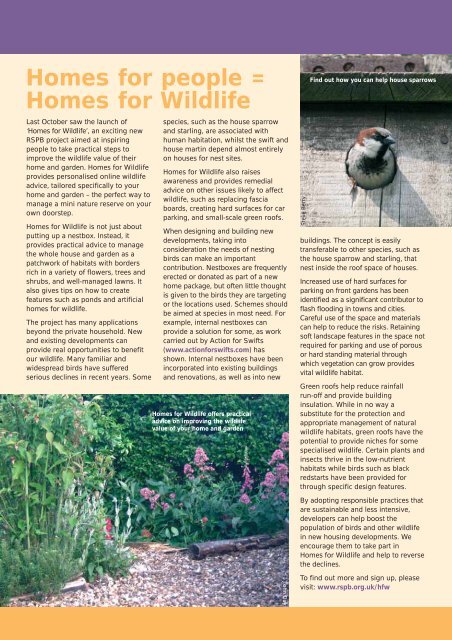Conservation Planner issue 28 - RSPB
Conservation Planner issue 28 - RSPB
Conservation Planner issue 28 - RSPB
Create successful ePaper yourself
Turn your PDF publications into a flip-book with our unique Google optimized e-Paper software.
Homes for people =<br />
Homes for Wildlife<br />
Last October saw the launch of<br />
‘Homes for Wildlife’, an exciting new<br />
<strong>RSPB</strong> project aimed at inspiring<br />
people to take practical steps to<br />
improve the wildlife value of their<br />
home and garden. Homes for Wildlife<br />
provides personalised online wildlife<br />
advice, tailored specifically to your<br />
home and garden – the perfect way to<br />
manage a mini nature reserve on your<br />
own doorstep.<br />
Homes for Wildlife is not just about<br />
putting up a nestbox. Instead, it<br />
provides practical advice to manage<br />
the whole house and garden as a<br />
patchwork of habitats with borders<br />
rich in a variety of flowers, trees and<br />
shrubs, and well-managed lawns. It<br />
also gives tips on how to create<br />
features such as ponds and artificial<br />
homes for wildlife.<br />
The project has many applications<br />
beyond the private household. New<br />
and existing developments can<br />
provide real opportunities to benefit<br />
our wildlife. Many familiar and<br />
widespread birds have suffered<br />
serious declines in recent years. Some<br />
species, such as the house sparrow<br />
and starling, are associated with<br />
human habitation, whilst the swift and<br />
house martin depend almost entirely<br />
on houses for nest sites.<br />
Homes for Wildlife also raises<br />
awareness and provides remedial<br />
advice on other <strong>issue</strong>s likely to affect<br />
wildlife, such as replacing fascia<br />
boards, creating hard surfaces for car<br />
parking, and small-scale green roofs.<br />
When designing and building new<br />
developments, taking into<br />
consideration the needs of nesting<br />
birds can make an important<br />
contribution. Nestboxes are frequently<br />
erected or donated as part of a new<br />
home package, but often little thought<br />
is given to the birds they are targeting<br />
or the locations used. Schemes should<br />
be aimed at species in most need. For<br />
example, internal nestboxes can<br />
provide a solution for some, as work<br />
carried out by Action for Swifts<br />
(www.actionforswifts.com) has<br />
shown. Internal nestboxes have been<br />
incorporated into existing buildings<br />
and renovations, as well as into new<br />
Homes for Wildlife offers practical<br />
advice on improving the wildlife<br />
value of your home and garden<br />
Steve Berry<br />
Find out how you can help house sparrows<br />
buildings. The concept is easily<br />
transferable to other species, such as<br />
the house sparrow and starling, that<br />
nest inside the roof space of houses.<br />
Increased use of hard surfaces for<br />
parking on front gardens has been<br />
identified as a significant contributor to<br />
flash flooding in towns and cities.<br />
Careful use of the space and materials<br />
can help to reduce the risks. Retaining<br />
soft landscape features in the space not<br />
required for parking and use of porous<br />
or hard standing material through<br />
which vegetation can grow provides<br />
vital wildlife habitat.<br />
Green roofs help reduce rainfall<br />
run-off and provide building<br />
insulation. While in no way a<br />
substitute for the protection and<br />
appropriate management of natural<br />
wildlife habitats, green roofs have the<br />
potential to provide niches for some<br />
specialised wildlife. Certain plants and<br />
insects thrive in the low-nutrient<br />
habitats while birds such as black<br />
redstarts have been provided for<br />
through specific design features.<br />
By adopting responsible practices that<br />
are sustainable and less intensive,<br />
developers can help boost the<br />
population of birds and other wildlife<br />
in new housing developments. We<br />
encourage them to take part in<br />
Homes for Wildlife and help to reverse<br />
the declines.<br />
John Day<br />
To find out more and sign up, please<br />
visit: www.rspb.org.uk/hfw
















